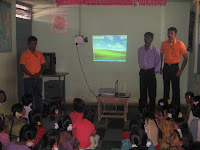Be an agent of social change!
We want leaders who:
Desire to create lasting social change
Are between 23-28 years of age (preferred)
Have earned a graduate or post-graduate degree
Possess at least 6 months work experience in the development sector
Applicants may be from any part of India but should be prepared to relocate to Northwest
Karnataka for the Fellowship period.
The Deshpande Center for Social Entrepreneurship
The Deshpande Fellowship Program
Marshalling Global Perspectives to Create Local Solutions.
DCSE building, BVB Engineering Collage Hubli, Karnataka 580 031.Phone: +011-91-836-237-8430 Email: infoDCSE@dfmail.org
About Deshpande Foundation: Founded in 1996 by Jaishree and Gururaj Deshpande, the Foundation is a leading philanthropic
organization in Massachusetts, USA, and India in the areas of innovation, entrepreneurship and international development. We
believe in creating sustainable social change, and we take a hands-on approach with our grant partners to help them achieve their
objectives.
About Deshpande Fellowship Program: The program is a unique opportunity for budding social entrepreneurs. The Fellowship is
an interactive, applied learning experience that aims to foster a generation of successful social entrepreneurs. Participants will
learn existing best practices and engage with the foremost social entrepreneurs and local innovators to develop a working knowledge
of leading social change models. The program will leverage this theoretical framework to aid each participant in the creation
of an individualized proposal for social change. Fellows will be expected to implement their innovations with partner institutions.
Twenty (25) Fellowships will be awarded. The last date for application is 20 March 2009. Women are encouraged to apply.
Period: Fellowships are for six months.
Fellowship Amount: The Fellowship amount is fixed at Rs. 7000 per
month with opportunities to increase amount to Rs. 12,000.
Selection: Short-listed candidates will be invited to visit Hubli for
group discussion and interviews.
Deadline: Apply by 20 March 2009.
Any Questions: E-mail fellowship@dfmail.org.
Visit www.deshpandefoundation.org/dcse to download an application
form to email to fellowship@dfmail.org or mail a hard copy to
address below. Shortlisted applicants will be asked to mail hard copies
of two recommendation letters.





